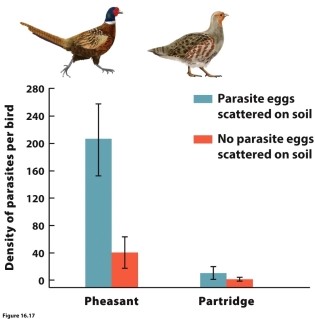Not Answered
 In the study of the gray partridge and ring-necked pheasant in the United Kingdom, researchers found that gray partridges were declining. A parasitic nematode seemed to negatively affect partridges. The pheasants that carried the parasites were not negatively affected. Researchers performed an experiment in which they allowed both species to feed in one of two enclosures: enclosures with parasite eggs scattered on the floor or enclosures without parasite eggs. The results are shown in the nearby figure. What did the researchers conclude? Was competition occurring, and if so what type?
In the study of the gray partridge and ring-necked pheasant in the United Kingdom, researchers found that gray partridges were declining. A parasitic nematode seemed to negatively affect partridges. The pheasants that carried the parasites were not negatively affected. Researchers performed an experiment in which they allowed both species to feed in one of two enclosures: enclosures with parasite eggs scattered on the floor or enclosures without parasite eggs. The results are shown in the nearby figure. What did the researchers conclude? Was competition occurring, and if so what type?
Correct Answer:

Verified
Correct Answer:
Verified
Q12: Researchers perform an experiment on a long-lived
Q13: When looking at a competitive interaction between
Q14: Organisms often have specific environmental requirements. For
Q15: Imagine a population of 600 mice
Q16: When two species compete for soil water,
Q18: Competition coefficients can be used to<br>A) identify
Q19: The result of a chi-square test
Q20: In David Tilman's experiments with the diatoms
Q21: Researchers studying the effects of hay-scented fern
Q22: When an individual drives down a resource